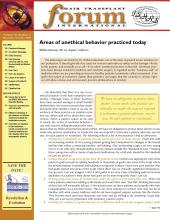For the last 16 months I have been using a running subcutaneous suture without knots exclusively and have found that my strip scars are considerably improved. This technique was first mentioned to me several years ago by Dr. Ed Epstein and, more recently, by Dr. Arthur Tykocinski (but with knots).
The Technique
Insert an absorbable suture about 5mm beyond the point of incision and then run it horizontally in the space between the bottom of the bulbs and the galea. Stay above the neurovascular plexi but avoid wandering superiorly and catching some hair follicles. I use 4-0 Biosyn but any braided absorbable suture should work equally well (Figure 1A).
Secure the end of the suture, if not using a knot, either with a hemostat or lead-free small fishing sinker. The latter is easy to clamp onto the suture (Figure 2A).
Take big subcutaneous bites up to a centimeter in size. Where the fat is too broken up or weak to hold a suture, take small bites of the galea being careful to avoid vessels (Figure 2B).
Avoid using the suture to pull the edges together during suturing. Tension clamps are used in advance of the suture to pull the skin edges together, and then on the already sutured section to pull the edges even closer together.
Upon reaching the end of the incision, run the suture back out of the skin about 5mm past the end of the incision and secure it with hemostat or another lead-free fishing sinker (Figure 2C).
Pull on the fishing sinker and cut the end of the suture at the skin level after closing the skin with a running suture (usually with a trichophytic closure). The suture will retract under the skin (Figure 1B, C, and D).
Some may be skeptical that fat will not hold the suture. I know of one surgeon who left a length of suture out of the skin at each end for a week and did not observe any pulling back into the skin, demonstrating that the suture could hold its tension even without tying a knot.
Practical Tips
Use tensions clamps or your forceps to pull the SQ together rather placing much tension on your suture. The SQ will pull together but not the skin surface edges.
The galea should not be visible before the skin surface closure. The follicles on the opposing walls should be parallel. The term “subcutaneous suture” has been used by many doctors to label what in reality are dermal sutures. In this technique it is truly “subcutaneous.”
Hemostats can get in the way and occasionally snap the suture. The use of lead-free clampable sinkers can avoid this problem and not affect the outcome.
The important aspect is really the subcutaneous closure. The decision to “knot” or “not knot” the ends of the SQ suture is mainly a personal preference.
Theoretical Advantages
It closes all of the dead spaces.
It aligns the hair follicles better.
It relieves much of the tension on the skin closure without damaging the follicular shafts.
It creates no confined space as do interrupted dermal or subcutaneous sutures.
It leaves no buried knots that can spit or cause discomfort.
Is it the answer to all bad scars? Unfortunately, no. There are still some occasional slightly stretched scars but so far they seem to be less than my scars from my previous technique of combined dermal interrupted sutures/cutaneous running sutures.
Give it a chance. You may find that a higher percentage of your scars are difficult if not impossible to detect.
- Copyright © 2009 by The International Society of Hair Restoration Surgery








